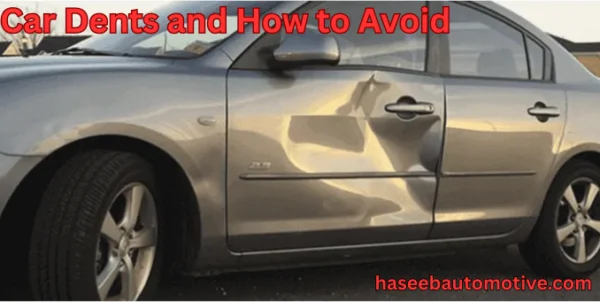Common Causes of Car Dents and How to Avoid Them
As a car owner, there’s nothing quite as frustrating as discovering a dent or ding on your vehicle.
Whether it’s from a parking lot mishap, a sudden hailstorm, or a careless passerby, dents can quickly take away from your car’s appearance.
While you might not always be able to avoid every dent, understanding the most common causes can help you take steps to prevent them.
In this article, I’ll walk you through some of the main reasons cars get dents and how you can avoid them.
1. Parking Lot Incidents
One of the leading causes of car dents is careless parking. We’ve all been in crowded parking lots where people are rushing to get in and out of their cars.
Unfortunately, that’s when door dings and scratches are most likely to occur.
How to Avoid Parking Lot Dents:
- Park Farther Away: Whenever possible, choose parking spots farther away from the entrance. While it might take a few extra steps, parking in less crowded areas reduces the chance of another car getting too close to yours.
- Choose End Spots or Corners: Opt for parking spaces at the end of rows or near walls. These spots are often less crowded, so you’ll have more space to maneuver your vehicle and avoid potential dings.
- Use Parking Sensors or Cameras: If your car has parking sensors or a rearview camera, always use them to park carefully and avoid accidentally scraping or bumping into other vehicles.
2. Hailstorms
Mother Nature can be unpredictable, and sometimes, a hailstorm can hit when you least expect it. Hail can cause dings and dents across your entire car, especially if the storm is severe.
While you can’t control the weather, there are ways to minimize the damage.
How to Avoid Hail Damage:
- Park Indoors: If you know a hailstorm is on the way, try to park your car in a garage or covered parking area. This is the best way to protect your car from the damaging effects of hail.
- Use a Car Cover: If you don’t have access to indoor parking, invest in a high-quality, padded car cover. These covers can provide a layer of protection against hail, helping to minimize damage.
- Find Shelter: If you’re caught in a hailstorm while driving, pull over safely and find shelter, such as under an overpass or in a parking lot, to protect your car from the worst of the hail.
3. Accidental Bumps from Other Vehicles
Sometimes, it’s not another car hitting your vehicle but your own. This could happen if you’re backing out of a driveway or parking space and accidentally bump into another car or an obstacle.
How to Avoid Accidental Bumps:
- Drive Slowly: Always drive cautiously, especially when reversing or navigating tight spaces. Slow and steady gives you more time to react and avoid bumps.
- Use Mirrors and Sensors: Ensure that your mirrors are properly adjusted and use parking sensors or cameras to help you maneuver safely. If your car doesn’t have them, consider installing aftermarket sensors for added safety.
4. Improper Door Handling
It’s easy to accidentally bump into your car’s door while opening it, especially if you’re in a cramped space or parked next to another car. This can lead to dings, especially on the door edges or panels.
How to Avoid Door Dings:
- Be Mindful When Opening Doors: When opening your car door, do so slowly and carefully, especially in tight spots. Always check the space around you to avoid hitting another car or object.
- Install Door Edge Guards: Consider installing rubber or plastic door edge guards to cushion the blow if your door comes into contact with another vehicle or object.
5. Flying Debris or Road Debris
While driving, small rocks, debris, and even branches from trees can get kicked up by your tires and hit the sides of your car. This can cause chips in your paint or small dents, particularly if the debris is large or hard enough.
How to Avoid Road Debris Damage:
- Drive Cautiously on Gravel Roads: If you find yourself driving on gravel or dirt roads, try to drive at a slower speed to reduce the chances of kicking up debris. Also, try to avoid driving directly behind other vehicles, as they can kick up debris onto your car.
- Regularly Inspect Your Tires: Tires that are improperly inflated or have uneven wear can increase the likelihood of debris getting kicked up. Make sure your tires are in good condition and properly inflated.
6. Bumping Into Objects in Your Garage
If you park in your garage, the risk of accidental dents increases when the space is cramped or cluttered. You might unintentionally bump into the walls, shelves, or other objects while trying to park.
How to Avoid Garage Dents:
- Clear Your Garage: Keep your garage organized and free of clutter so you have plenty of space to park. This will reduce the chances of bumping into objects while parking.
- Install Parking Guides: Consider installing parking guides or bumpers along the walls or floor of your garage. These can help you park more accurately and avoid scraping or bumping into your garage’s walls.
7. Children and Pets Playing Around Your Car
If you have kids or pets, they might occasionally run into your car while playing outside. The impact of a ball, skateboard, or bicycle can cause dents, especially on the sides or bumpers.
How to Avoid Dents from Kids and Pets:
- Create a Safe Zone for Play: Designate a specific area for your kids or pets to play that’s away from your parked car. This can help minimize the risk of them accidentally bumping into your vehicle.
- Supervise Outdoor Play: If your car is parked outside, keep an eye on the kids or pets while they play nearby. Encouraging them to play away from the car can help prevent accidental damage.
8. Poor Parking Practices of Others
Sometimes, dents are caused by the negligence of others. This can happen if someone opens their car door too forcefully, bumps into your vehicle while parking, or drives too close to your car.
How to Avoid Damage from Other Drivers:
- Park in Safe Locations: Whenever possible, park in less crowded areas with fewer vehicles around. This will reduce the chance of other cars hitting yours.
- Use Protective Film or Door Guards: If you’re particularly concerned about door dings or scratches, consider applying a protective film to your car’s vulnerable areas or using door guards to cushion potential impacts.
While some car dents are inevitable, there are plenty of steps you can take to avoid the most common causes.
From parking smartly to protecting your vehicle with covers and guards, a little prevention goes a long way in preserving your car’s appearance.
At HaseebAutomotive.com, we’re always sharing helpful tips and advice to ensure your car stays in top shape, inside and out. By being aware of the causes and taking proactive steps, you can minimize the risk of dents and keep your car looking as good as new!



Leave a Reply